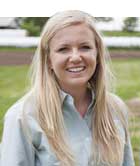Spring seeding success |
| By Sydney Sleep |
|
|
 April is one of the two preferred times to plant cool-season perennial forages. The other time is in late summer. “The relative success of spring versus summer seeding of forages is greatly affected by the prevailing weather conditions, so there are successes and failures with each planting time,” says Mark Sulc, Ohio State University extension forage specialist. In the Ohio State extension newsletter, C.O.R.N., Sulc notes that the two main difficulties with spring planting are finding a window of opportunity when soils are dry enough but before it is too late, and managing weed infestations that are typically more difficult with spring plantings. According to Sulc, the following steps will aid in successful forage establishment in the spring. 1. Be sure soil pH and fertility are in the recommended ranges. Forages are more productive when soil pH is above 6.0. However, for alfalfa, pH should be from 6.5 to 6.8. If planting alfalfa and soil pH is not at least 6.5, the best option may be to apply lime now and delay establishing alfalfa until late summer. An annual grass forage can be planted in the interim. Also make certain that phosphorus and potassium soil fertility levels meet optimum levels for the species being planted. 2. Plant high-quality seed of known varietal source adapted to your region. Planting “common” seed usually yields less, even in the first or second year, and has shorter stand life. 3. Plant as soon as possible in order to prepare a good seedbed. Timely planting in April allows forage seedlings the best opportunity to get ahead of weeds and to be established before summer stress sets in. 4. Plant into a good seedbed, and don’t overwork the soil. Too much tillage depletes moisture and raises the risk of surface crusting. Firm the seedbed prior to seeding to ensure good contact with the soil and to reduce the rate of drying. Cultipackers and cultimulchers work well for firming the soil. If residue cover is more than 35 percent, use a no-till drill. Where soil erosion is a hazard, no-till seeding is a reasonable option. 5. Plant seed at about 0.25 to 0.5 inch. Check the actual depth of the seed in the field at the start of planting. This is especially important with no-till drills. 6. When seeded into a tilled seedbed, drills with press wheels are the best option. When seeding without press wheels or if broadcasting seed, cultipack before and after dropping the seed, preferably in the same direction the seeder was driven. 7. In fields with little erosion hazard, direct seedings without a companion crop in the spring allow harvesting two or three crops of high-quality forage in the seeding year, especially when using alfalfa or red clover. 8. Planting a small grain companion crop with conventional seedings on erosion-prone fields can reduce erosion and help compete with weeds. Companion crops typically improve total forage tonnage in the seeding year, but quality will be lower than direct seeded legumes. To avoid excessive competition of the companion crop with forage seedlings, use early maturing, short, and stiff-strawed small grain varieties; plant companion small grains at 1.5 to 2.0 bushels per acre, and do not apply additional nitrogen to the companion crop. 9. During the first six to eight weeks following seeding, scout new seedings weekly for developing weed or insect problems. In particular, potato leafhopper damage on legumes can be a concern starting in late May to early June. 10. Delay the first harvest of the new seeding until early flowering of legumes, unless weeds were not adequately controlled and threaten to take over the stand. For pure grass seedings, generally harvest 70 days after planting, unless weeds are encroaching and the stand needs to be clipped earlier.  Sydney Sleep Sydney Sleep was the 2016 Hay & Forage Grower summer editorial intern and is a junior at South Dakota University. |
